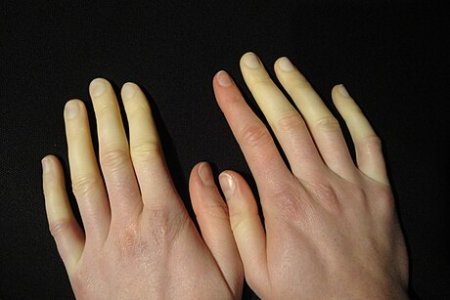Numbness in your extremities could signal a serious health issue – find out if it’s Raynaud’s or worse!
- Replies 0
When winter nips at your nose, it's not just a quaint holiday lyric—it's a reality for many of us braving the winter chill.
But when that nipping turns into a numbing sensation in your fingers and toes, accompanied by a ghostly pallor or a blue-like hue, it's time to pay attention.
This isn't just a case of the winter blues; it could be a sign of Raynaud's phenomenon, or it might indicate something more serious. Let’s dive into the frosty facts to help you understand what your body is telling you.
Raynaud's syndrome, also known as Raynaud's phenomenon, is like your body's overzealous thermostat reacting to a slight chill in the air.
Dr. Anca Askanase, a rheumatologist at Columbia University Medical Center, describes it as “an overreaction to the normal cold-induced symptoms.”
This means that even in mildly cold conditions, people with Raynaud's can experience a dramatic reduction in blood flow to their extremities, causing fingers and toes to turn white, then blue, and feel numb or even painful.
This condition isn't just a winter woe; it can strike any time the temperature drops, making it a year-round concern for those affected.

While it's more prevalent in women and typically begins before age 30, secondary Raynaud's—triggered by another condition or medication—can start at any age.
The sight of blue or white digits might send shivers down your spine, but it's not always a frostbite fright.
Raynaud's can occur with just a hint of cold, while frostbite is a cruel consequence of extreme cold that can lead to tissue damage. If you're experiencing these symptoms frequently in chilly environments, it's likely Raynaud's at play, not frostbite.
Frostbite's telltale signs include hard, waxy skin, whereas with Raynaud's, the skin texture remains unchanged.
The good news? Raynaud's is generally reversible with warmth, though prolonged exposure to cold without warming up can lead to sores, tissue loss, and in rare cases, gangrene.
If you find yourself caught in the cold grip of numbness, don't despair. It may take a while for the feeling to return once you're in a warmer environment, but there are ways to hasten the thaw.
Dr. Askanase recommends gently warming the affected areas with lukewarm water—never hot, as your numbed skin is more susceptible to burns.
If you're experiencing these symptoms, it's wise to consult a healthcare professional.
Source: Doctor O’Donovan / Youtube.
A doctor can diagnose Raynaud's and rule out associated diseases like scleroderma and lupus. Early detection and management are key to keeping your extremities happy and healthy.
Living with Raynaud's means becoming a cold-weather strategist. Here are some tactics to keep flare-ups at bay:
- Bundle Up: Limit your exposure to the cold. When venturing outside, don warm gloves and extra socks. Hand warmers are your portable heat buddies.
- Stay Dry: Wetness is a fast track to numbness. Ensure your boots are leak-proof and your gloves are moisture-resistant.
- Get Moving: Exercise boosts circulation, so keep those limbs in motion.
- Stress Less: Stress can exacerbate Raynaud's, so find your zen through relaxation techniques or hobbies that calm the mind.
Also read: Experts reveal their top secrets to keeping your family cozy and safe this winter–don’t miss out!

Have you experienced the numbing touch of Raynaud's? What are your go-to methods for keeping warm? Or perhaps you have concerns about other symptoms that arise in the cold? Share your stories and questions in the comments below!
But when that nipping turns into a numbing sensation in your fingers and toes, accompanied by a ghostly pallor or a blue-like hue, it's time to pay attention.
This isn't just a case of the winter blues; it could be a sign of Raynaud's phenomenon, or it might indicate something more serious. Let’s dive into the frosty facts to help you understand what your body is telling you.
Raynaud's syndrome, also known as Raynaud's phenomenon, is like your body's overzealous thermostat reacting to a slight chill in the air.
Dr. Anca Askanase, a rheumatologist at Columbia University Medical Center, describes it as “an overreaction to the normal cold-induced symptoms.”
This means that even in mildly cold conditions, people with Raynaud's can experience a dramatic reduction in blood flow to their extremities, causing fingers and toes to turn white, then blue, and feel numb or even painful.
This condition isn't just a winter woe; it can strike any time the temperature drops, making it a year-round concern for those affected.

Raynaud's syndrome is a condition where blood vessels overreact to cold, causing fingers and toes to turn white, blue, and feel numb. Image source: Niklas D. / Wikimedia Commons.
While it's more prevalent in women and typically begins before age 30, secondary Raynaud's—triggered by another condition or medication—can start at any age.
The sight of blue or white digits might send shivers down your spine, but it's not always a frostbite fright.
Raynaud's can occur with just a hint of cold, while frostbite is a cruel consequence of extreme cold that can lead to tissue damage. If you're experiencing these symptoms frequently in chilly environments, it's likely Raynaud's at play, not frostbite.
Frostbite's telltale signs include hard, waxy skin, whereas with Raynaud's, the skin texture remains unchanged.
The good news? Raynaud's is generally reversible with warmth, though prolonged exposure to cold without warming up can lead to sores, tissue loss, and in rare cases, gangrene.
If you find yourself caught in the cold grip of numbness, don't despair. It may take a while for the feeling to return once you're in a warmer environment, but there are ways to hasten the thaw.
Dr. Askanase recommends gently warming the affected areas with lukewarm water—never hot, as your numbed skin is more susceptible to burns.
If you're experiencing these symptoms, it's wise to consult a healthcare professional.
Source: Doctor O’Donovan / Youtube.
A doctor can diagnose Raynaud's and rule out associated diseases like scleroderma and lupus. Early detection and management are key to keeping your extremities happy and healthy.
Living with Raynaud's means becoming a cold-weather strategist. Here are some tactics to keep flare-ups at bay:
- Bundle Up: Limit your exposure to the cold. When venturing outside, don warm gloves and extra socks. Hand warmers are your portable heat buddies.
- Stay Dry: Wetness is a fast track to numbness. Ensure your boots are leak-proof and your gloves are moisture-resistant.
- Get Moving: Exercise boosts circulation, so keep those limbs in motion.
- Stress Less: Stress can exacerbate Raynaud's, so find your zen through relaxation techniques or hobbies that calm the mind.
Also read: Experts reveal their top secrets to keeping your family cozy and safe this winter–don’t miss out!
Key Takeaways
- Raynaud's syndrome is a condition where blood vessels overreact to cold, causing fingers and toes to turn white, blue, and feel numb.
- It's more common in women and usually starts before the age of 30, although it can occur later if associated with other conditions or medications.
- Warming up the affected areas gradually with warm water can help alleviate the symptoms; however, care should be taken to avoid burns.
- Consultation with a doctor is advised to diagnose the condition and rule out any associated diseases, with management including reducing cold exposure, keeping dry, and minimising stress.
Have you experienced the numbing touch of Raynaud's? What are your go-to methods for keeping warm? Or perhaps you have concerns about other symptoms that arise in the cold? Share your stories and questions in the comments below!






